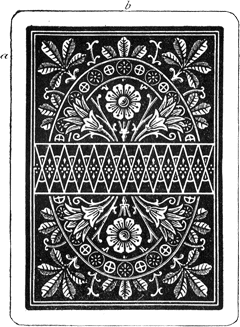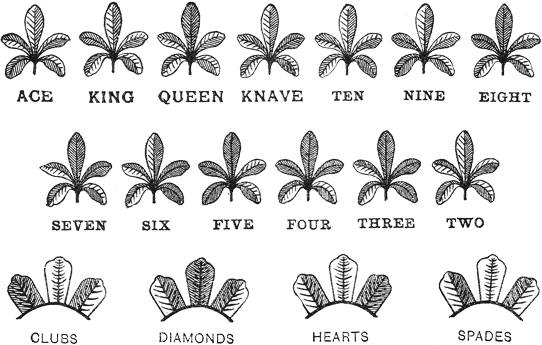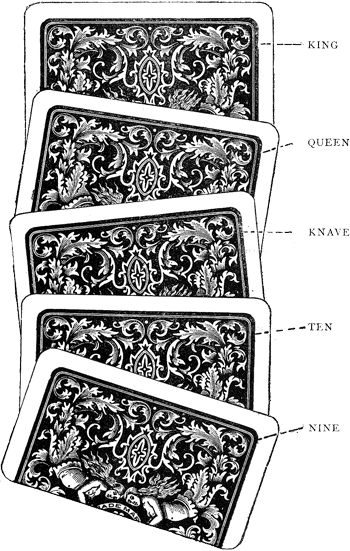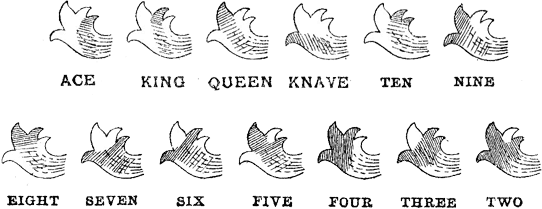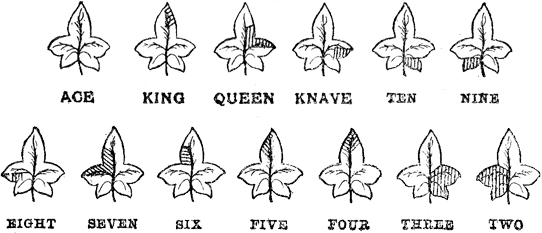
|
foreword to the online edition I. introductory II. common sharpers and their tricks III. marked cards and the manner of their employment IV. reflectors V. holdouts VI. manipulation VIII. the game of faro IX. prepared cards X. dice XI. high ball poker XII. roulette and allied games XIII. sporting houses XIV. sharps and flats
|
SHARPS AND FLATS
CHAPTER III MARKED CARDS AND THE MANNER OF THEIR EMPLOYMENT
§ F -- Line and scroll workThis is the kind of marking which is adopted by the most expert among card-sharpers. When well done it can hardly be detected even by another sharper. This system may be briefly summarized as follows. Some convenient portion of the card-back is selected a flower or some similar device in the pattern, for instance and a shading consisting of very fine lines, in imitation of the normal shading of the pattern, is used, its position indicating the value of the card. A specially prepared 'line-work fluid' is used, and the work is put on with a fine pen or, better still, with a fine sable pencil. In using a pen there is always a danger of scratching the enamel, but by the use of a 'photographic sable,' such as retouchers employ, this is obviated. In order to imbue the reader with a due appreciation of these works of art, our first example shall be one of a very obvious character; one that could only be used in a 'soft game.'1 We shall then have an opportunity of comparing it with one or two of the masterpieces of the century, and, looking back upon the earlier pages of this book, we can reflect upon the manner in which the science of card-sharping is progressing, like other and more legitimate sciences. *1 -- This expression does not apply, as might be imagined, to the comparative simplicity of the game, but rather to the positive simplicity of the players. Fig. 13 A portion of the pattern, consisting of five projections, is usually chosen in line-marking, and the line work is applied in the following manner. The first projection, or petal, on the left, is shaded to denote an ace; the second a king; the third a queen; the fourth a knave; and the fifth a ten. Then for a nine, the first and second are shaded; for an eight the second and third; and so on to the six. Lastly, taking the foliations in groups of three, the first three represent the five; the second, third, and fourth, the four; and the third, fourth, and fifth, the three. The two is not shaded. In the case of the card which is reproduced in fig. 13, the spray of leaves marked a would be chosen to indicate the values. The spray b would be shaded to denote the suit. Reference to fig. 14 will serve to make this clear. Having mastered this elementary method, we will now turn to some of the finest work that has ever been put upon cards. Fig. 15 illustrates five cards of the 'angel- back' pattern. These are respectively the king, queen, knave, ten, and nine. It is not too much to say that the mark would never be discovered without assistance being given, by one previously acquainted with it.
FIG. 14
FIG. 15 In this example the spray marked c (fig. 11) is chosen, and marked in a manner of which fig. 16 is a magnified diagram.
FlG. 1 6
As a concluding example of line-work, if the reader will turn back to fig. 8, he will find, in each corner of the pattern upon the card, a leaf with five points, an ivy leaf in fact. In marking a genuine card of this pattern, this leaf would be selected for the purpose, and shaded with line-work after the manner of fig. 17.
FIG. 17
|
| « marked cards... (shading and tint-marking) | marked cards... (...marked whilst in play) » |
home | introduction | book content | links | advertising | contact
